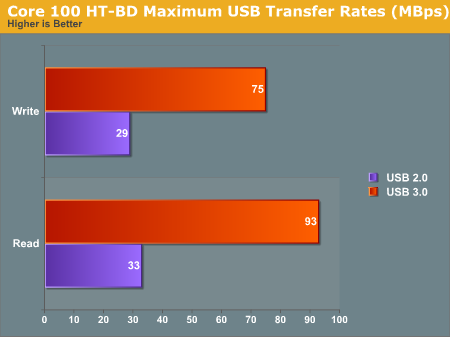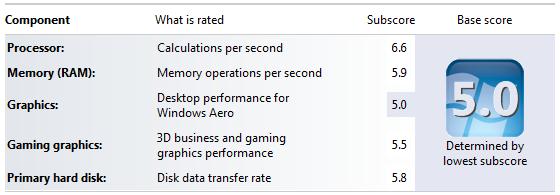ASRock Core 100HT-BD : Bringing HTPCs to the Mainstream Market [UPDATED : Noise Issue]
by Ganesh T S on July 19, 2010 9:34 PM EST- Posted in
- Home Theater
- Arrandale
- ASRock
- Media Streamer
- Core i3
- HTPC
Do the usual benchmarks really provide us with a proper indicator of the worthiness of a HTPC? Is that the performance seen by an average user in real life situations? Such questions often crossed my mind when I looked up the reviews of PCs on various websites. It is almost blasphemous if one were to suggest that the 'Windows Experience Index' is a reflection of what the average user sees. Such a synthetic benchmark might not be a true reflection of the capabilities of the system, but it at least gives an idea to the users as to how much better the system would be compared to the one they currently possess. HTPCs require a different set of performance measurement tests, and we will handle them in the next set of sections. In this, however, we will talk about the general performance metrics in brief.
For readers wanting a lowdown on the core performance aspect (in other words, graphs for various standardized benchmarks) of the motherboard used in this PC, I would suggest reviews from Legion Hardware and Benchmark Reviews. We found nothing in our experiments to dispute their findings. However, one important aspect we would like to cover here is the USB 3.0 performance.
USB 3.0 on the HM55 Chipset
We hooked up OCZ's Enyo 128 GB USB 3.0 external SSD (which has received glowing reviews everywhere with upto 200 MBps read and 190 MBps write speeds) to the front USB 3.0 ports of the Core 100 HT-BD. Contrary to our expectations, we managed to get a maximum of only 93 MBps read and 75 MBps write performance out of the drive. Connecting the same SSD to an USB 2.0 port resulted in a maximum of 33 MBps reads and 29 MBps writes, in line with expectations. We do not get the fabled 10x, but only a 2.7x, improvement over USB 2.0 with the Core 100 HT-BD's USB 3.0 implementation.

A little more analysis revealed that the HM55 chipset does not support PCI-E v2 fully and the bandwidth is limited by the chipset. To get around this limitation, ASRock could have placed a PLX bridge chip on board. We covered this workaround in detail in an earlier piece, but it doesn't make sense for ASRock to implement it in this product. The existing limitation will not be of concern to most users, as SSDs are yet to go mainstream (because of their cost). Most external hard disks with USB 3.0 or eSATA interfaces are inherently limited by the disk-to-buffer transfer rate of around 70 - 90 MBps, and ASRock's USB 3.0 implementation is capable of handling such bandwidth.
Windows Experience Index
A quick glance through the specifications of the system easily reveals the bottleneck affecting the score on the Windows Experience Index. It is none other than Intel's integrated GPU which ends up being the culprit. A screenshot of the Windows Experience Index shows the system chiming in at 5.0. However, we have seen the scores oscillate between 4.4 and 5.2 depending on the graphics driver version, as well as the GPU overclocking status.

Of particular interest is the impressive score received by the processor (6.6), indicating that the performance of this unit would be more than enough for most, if not all, HTPC applications.
DPC Latency Check
Another important criterion for HTPCs is the ability of the system to handle real time streaming of audio and video without dropouts. A handy tool called the DPC Latency Checker helps in analyzing this. This tool was run multiple times in various HTPC scenarios. We did observe red spikes, but disabling the C-states, as well as SpeedStep in the BIOS Advanced CPU configuration helped in alleviating the issue. However, we did not observe any dropouts or playback issues with Blu-Ray or any other media despite the sporadic occurrence of these spikes.
Miscellaneous Performance Indices
Pre-built HTPCs available today are mostly based on the ION chipset, and any comparative evaluation of the benchmark results of this system with ION systems would be grossly unfair for the ION. Both Benchmark Reviews and Legion Hardware compared the Core 100 HT with the ION 330, the 2009 HTPC model from ASRock. Comparing the performance of the Atom to the Core i3 is like comparing apples to oranges, but, for the record, the Core 100 HT system came out better on almost all counts except for the 3D and gaming performance.
On the memory bandwidth side, the Core 100 has more than 2x the performance of the ION 330. CPU performance is around 4 - 5x better. While games appeared to achieve almost similar frame rates on both the Core 100 and the ION 330, 3D performance in applications such as Maya went down by a factor of 2x in favour of the ION 330. Thankfully, applications such as video encoding (a common overnight task for most HTPCs) see a 3.5x performance improvement in the Core 100HT-BD.
In the next section, we will look at the integrated GPU of the Core i3-330M in detail.










107 Comments
View All Comments
ck_mb - Tuesday, July 20, 2010 - link
Does the video card pass WMC cablecard test? I have a AMD 780G that doesn't, since this motherboard doesn't have any expanision slot it would be worthless as a dvr using cablecards.ganeshts - Wednesday, July 21, 2010 - link
Yes, the system passes the Digital Cable Advisor test without any issues.schoenbe - Wednesday, July 21, 2010 - link
An HTPC without a TV tuner is not an HTPC. It is a media player.In the case of the Core-100HT-BD reviewed here, a powerful media player. But you still can't watch TV with it. You cannot record TV with it. Not even a single channel, let alone several channels simultaneously. Anandtech should not recommend this unit as an HTPC. Besides, $700 for a media player? For playing back BD discs and media files? Not sure who wants to pay this much for an incomplete feature set.
DigitalFreak - Wednesday, July 21, 2010 - link
If you don't like it, don't buy it. Is someone standing there with a gun to your head?EnzoFX - Wednesday, July 21, 2010 - link
In my experience, USB tuners are the easiest for people to work with. This unit is targeted at people who probably wouldn't be willing to open up a computer case and install an internal tuner IMO. Personally, I think the best tuner is the HDHomeRun, which is a network based tuner, so this ASRock unit definitely delivers in every regard.schoenbe - Thursday, July 22, 2010 - link
"... this ASRock unit definitely delivers in every regard." Really? Even if you have to go out and buy a TV Tuner and make it work? This product definitely doesn't deliver the complete package.Ipatinga - Wednesday, July 21, 2010 - link
In the article, there is a part where it says "... One must also take into consideration the cost of the Atheros AR9287, which can be bought for around US $15 online..."Where can I find Mini PCI Express 1x Wireless Adapters (Half Height or not) like this Atheros AR9287 this cheap ($15)?
Thanks :)
ganeshts - Thursday, July 22, 2010 - link
This is the listing I was referring to:http://cgi.ebay.com/Atheros-Dual-Band-AR9287-Wirel...
cjs150 - Thursday, July 22, 2010 - link
Ganeshts: I think you and I have different definitions of noisy. Lets take a simple and real life example.I am listening to classical music - obviously a quiet section, the 1812 overture can be heard over a jet engine!
At same time I have firefox up and running (couple of tabs one of which is of course Anandtech but the other is a chess site I use)
I am also running a chess analysis program, fritz, which will take whatever CPU capacity you through at it
Pretty obviously under this scenario the IGP is not fully loaded but the CPU could be running close to capacity.
My Sofa is 6ft away.
If I can hear the ASRock then it is too loud. By comparison my main work rig (admittedly water cooled), I cannot hear other than possible a very slight noise of air movement.
We all know that manufacturer claims of noise levels are typically overstated (expecially by fan manufacturers) but to be suitable for me the noise (close to the machine) has to be sub 30db or even sub 25db. It is not difficult but does limit the cooling to a slow running 140+mm fan.
Mind you the loudest thing in the living room (apart from my daughter) has to be the cable set up box - but only when it starts up from sleep, some really bad design I think there
ganeshts - Thursday, July 22, 2010 - link
cjs150,Noise is a very subjective issue. What might be noisy to me might be OK to you, or vice versa. It is really hard to say what the "ideal" dB would be (aside from silent of course). Some people seem to have the hearing of a bat, while others are more tolerant.
For the correct judgement, you will have to experience it yourself, unfortunately.
The hobbyist sound meter we used could barely register anything unless it was very close to the unit (as you can see from the photo). At 2 ft away, manufacturer shows proof of 34.5 dB (Please check UPDATE section on Page 11).
I am not even sure there are professional sound meters to measure sub 30 and sub 25 dB unless you have an anechoic room.
The figures are presented, and in our opinion, at this cost and for this form factor, ASRock appears to have done the best it could do. Whether the figures are acceptable to you or not, I can't judge from here :)
Our review of this product was from the perspective of the average HTPC user ( not people with 7 TV tuners, for instance ;) )